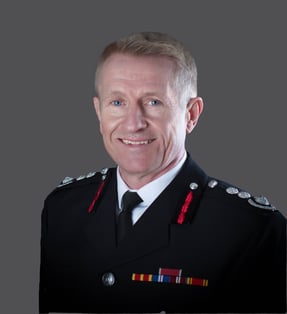The Central and Local Government Hub spoke to Roy Wilsher, Chair of The National Fire Chiefs Council (NFCC) and asked him a few questions on what 2020 holds for UK Fire and Rescue Services.
Q. In January 2020, HMICFRS released their State of Fire and Rescue Annual Assessment for 2019, what impact do you think the assessment and inspections will have on Fire and Rescue Services across the UK?
The HMICFRS report is an important point in the future of the English fire and rescue service. We have not had an independent review for some years as a consequence of government policy, so we welcome this scrutiny. The report is, however, just one of a number of influences that will shape our work.
Overall, I am pleased that the State of Fire report has been published and I acknowledge the recommendations within it. I look forward working with partners – including the Home Office, LGA and trade unions – to see where we can implement meaningful change for the benefit of services and most importantly, the communities we serve.
But as mentioned, consideration of HMICFRS’s recommendations is important but just one factor in our deliberations alongside issues such as the Grenfell Tower Inquiry recommendations, the upcoming comprehensive spending review and new building safety regime. It is important to note the recommendations all have interdependencies and require a joined-up approach and are not considered in isolation.
I was pleased to see the report highlighted where the sector has strengths, including the reference to: ‘The determination and dedication to protect life and property are second to none’. It is particularly pleasing to see emergency response maintaining standards, it has been the foundation of all our current work. Excellence in response, prevention and fire protection are key. I am in no doubt that all fire and rescue services take enormous pride in responding to the communities they serve, based on their needs and identified risk.
As you would expect, the report also highlights where the Inspectorate feels there is room for improvement. NFCC, as the professional voice of the sector, is exploring these and will work with other interested parties to address HMICFRS concerns. In fact, work in a number of areas is already underway within the NFCC programmes, but we cannot tackle the far-reaching recommendations in isolation.
Since the findings of the first tranche of inspections were published, all subsequent reports have consistently highlighted fire services reduced protection capacity. I believe this is largely a result of austerity measures and fire services having to make difficult decisions as to where they prioritise resources.
I would also like to see HMICFRS exercise caution with refence to building regulations. Overall responsibility for this sits with government and local authorities - not fire services. It is imperative the failure of the building safety system is not placed solely at the door of the FRS.
Q. The reduction in the demand for FRS’s to respond solely to fire incidents have seen services diversify their portfolios, such as local road safety education programmes. Do you believe this shift in focus is positive for the sector?
One of the challenges we have had to deal with over many years is government making a direct correlation between the number of fires and the resources fire and rescue services need. This is a misunderstanding of how we operate, we operate on risk, not demand. The reduction in demand also led to a general feeling that Fire was a ‘done deal’. Unfortunately, with the building safety programme, we can see this is far from true. Diversification is welcomed as long as it is evidence-based within a solid integrated risk management plan that ensures excellence in our core roles of Prevention, Protection, Response and Resilience.
Q. One of the main findings from the HMICFRS stated that too many services are operating under toxic cultures, with 24% of staff feeling bullied or harassed at work in the past 12 months. What work is the NFCC undertaking to support services to improve inclusivity and workplace culture?
This area cannot go unmentioned; HMICFS have referred to a toxic culture, but questioning this finding shows that this might be true in a small number of fire services. I would like to see a stronger evidence-base research to understand if there really is a culture of bullying in these services, or whether it is national factors such as pay, pensions and change that influence this reporting.
Let me make it clear that NFCC is not complacent about this; our national People Programme is already working on this area and looking at whether fire services need to act to address this and where NFCC can assist via national initiatives. One personal concern is that many headlines I saw picked up on this part of the report and if people perceive this reflects every FRS then we may well have even more difficulty recruiting the diverse workforce we need. I am also clear that we must continue to strive for inclusion, so diversity in all its forms is embraced and the fire and rescue service becomes a job of choice for all.
Q. Finally, as Chair of the NFCC what main issues and areas will you be focusing on throughout 2020?
It is unfortunately a familiar list, the continue aftermath of the Grenfell Tower tragedy, including the Building Safety Programme, new regulator and changes to the Fire Safety Order. The comprehensive spending review, the recommendations of HMICFRS, working closely with stakeholders and partners such as government, the Local Government Association, trade unions and industry. Implementing the revised NFCC strategy and pushing forward on our programmes of work and supporting fire services and fire authorities across the UK to be the best possible fire and rescue organisations serving the public and reducing risk.
